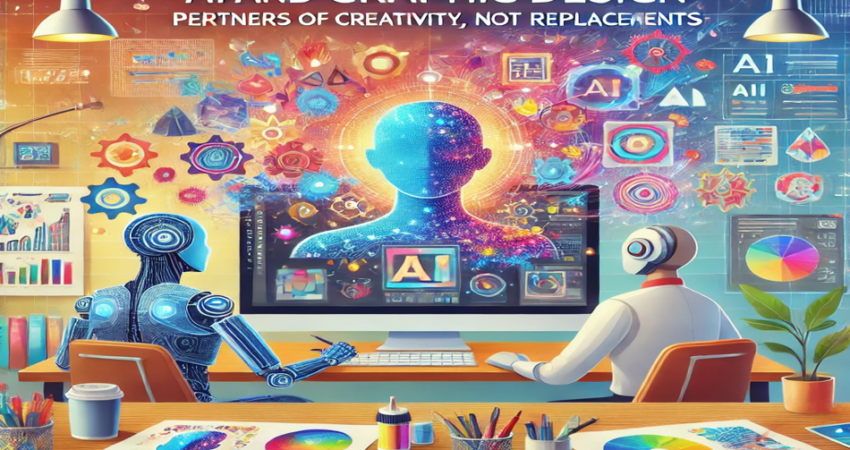
sejistudio
- 13 Nov 2024
- 5 min read
5 Reason Why AI Wont Replace Graphic Designers Anytime Soon
The rise of artificial intelligence (AI) in graphic design has brought both excitement and apprehension. With AI tools now capable of creating stunning visuals, many people wonder: will AI eventually replace graphic designers? While AI is transforming the industry and changing how designers work, it’s unlikely to fully replace the creative, strategic role of a human designer. Instead, AI will continue to serve as a powerful partner, enhancing creativity, efficiency, and productivity. Let’s explore why AI is unlikely to take over entirely and how it’s shaping the future of graphic design.
1. Creativity and Emotional Intelligence
AI excels at recognizing patterns and generating visuals based on algorithms, but design requires more than technical skills. It demands creativity, emotional intelligence, and cultural awareness—qualities that are uniquely human. Graphic designers understand how to interpret human emotions and cultural nuances, crafting visuals that resonate with audiences on a personal level. Adobe Firefly ,for example, provides some innovative tools for idea generation but still relies on human creativity for meaningful design.
2. Unique Brand Identity and Storytelling
Brand identity is more than just a logo or a colour scheme; it’s a story that represents the values, mission, and personality of a brand. Designers play a vital role in developing cohesive brand narratives that go beyond individual visuals. While AI can create beautiful design elements, it lacks the strategic understanding of how these elements fit into a larger brand story. For instance, platforms like Canva offer AI tools to quickly create design elements, but the human touch is essential for truly connecting with audiences.
3. Customization and Human Touch
AI-generated designs are often based on templates and algorithms, which can make them look polished but, at times, generic. Designers add a personal touch, customizing designs to reflect the subtle preferences and personality of their clients. This level of personalization is particularly important in fields like branding, where unique identity is everything. Tools like Midjourney help designers explore styles and aesthetic ideas, but true customization depends on a designer’s intuition and attention to detail.
4. Complex Problem Solving and Innovation
Graphic design goes beyond aesthetics; it’s a problem-solving process that often involves finding innovative solutions to specific challenges. Designers must think critically and creatively to convey messages clearly, especially when working with constraints like brand guidelines or specific audience needs. DALL-E , for instance, is great for concept generation but doesn’t have the strategic insight to approach complex design problems independently.
5. Collaboration and Communication
Graphic design is rarely a solo activity; it often involves collaboration with clients, marketing teams, and other stakeholders. Designers navigate these relationships, interpreting feedback, balancing expectations, and iterating on designs to achieve a shared vision. This interpersonal skill set is critical for a successful project, and AI simply doesn’t possess it. Tools like Figma with AI-powered plugins facilitate collaboration, but designers are key to effectively managing communication.
How AI is Shaping the Future of Graphic Design
While AI may not replace designers, it’s certainly reshaping their roles and how they work. Here are a few ways AI will continue to impact the design field:
- Idea Generation: AI is a powerful brainstorming partner. Designers can use tools like DALL-E or Midjourney to explore concepts, experiment with different styles, and generate new ideas that can serve as the foundation for their projects.
- Efficiency and Automation: By handling repetitive tasks—such as resizing images, removing backgrounds, and making quick adjustments—AI tools allow designers to focus more on creativity. This efficiency boost enables designers to complete projects faster without getting bogged down by time-consuming manual work.
- Enhanced Personalization: AI tools can analyze user data and provide valuable insights that help designers create more personalized visuals. Canva’s Magic Studio and Adobe Firefly are leading the way in offering AI-driven personalization options.
- Continuous Learning: AI systems learn from designer feedback, which means they will only become more sophisticated and adaptable over time. As AI tools evolve, they’ll be able to provide more relevant suggestions, becoming an even more integral part of the creative process.
Final Thoughts: AI as a Creative Partner, Not a Replacement
Rather than replacing graphic designers, AI is expanding what it can accomplish. By using AI to handle repetitive tasks, generate ideas, and enhance efficiency, designers can focus on the elements of their work that require a human touch: creativity, emotional intelligence, strategic insight, and collaboration. The best results will come when designers and AI work together, with AI augmenting human skills and allowing designers to achieve more than they could on their own.
In the foreseeable future, graphic design is likely to remain a hybrid field where AI tools support human creativity. Embracing AI as a creative partner, not a replacement, can lead to a new era of innovation and artistic expression in graphic design. AI will keep transforming the field, but the designer’s unique blend of creativity, strategy, and empathy will always remain at the heart of great design.






